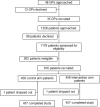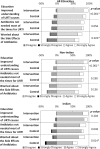Results from a Patient-Based Health Education Intervention in Reducing Antibiotic Use for Acute Upper Respiratory Tract Infections in the Private Sector Primary Care Setting in Singapore
- PMID: 28193663
- PMCID: PMC5404603
- DOI: 10.1128/AAC.02257-16
Results from a Patient-Based Health Education Intervention in Reducing Antibiotic Use for Acute Upper Respiratory Tract Infections in the Private Sector Primary Care Setting in Singapore
Abstract
We investigated the efficacy of patient-targeted education in reducing antibiotic prescriptions for upper respiratory tract infections (URTIs) among adults in the private primary care setting in Singapore. Our randomized controlled trial enrolled patients aged 21 years and above presenting at general practitioner (GP) clinics with URTI symptoms for 7 days or less. Intervention arm patients were verbally educated via pamphlets about the etiology of URTIs, the role of antibiotics in treating URTIs, and the consequences of inappropriate antibiotic use. Control arm patients were educated on influenza vaccinations. Both arms were compared regarding the proportions prescribed antibiotics and the patients' postconsultation views. A total of 914 patients consulting 35 doctors from 24 clinics completed the study (457 in each arm). The demographics of patients in both arms were similar, and 19.1% were prescribed an antibiotic, but this varied from 0% to 70% for individual GPs. The intervention did not significantly reduce antibiotic prescriptions (odds ratio [OR], 1.20; 95% confidence interval [CI], 0.83-1.73) except in patients of Indian ethnicity (OR, 0.28; 95% CI, 0.09-0.93). Positive associations between the intervention and the view that antibiotics were not needed most of the time for URTIs (P = 0.047) and on being worried about the side effects of antibiotics (P = 0.018) were restricted to the Indian subgroup. GPs in limited liability partnerships or clinic chains prescribed less (OR, 0.36; 95% CI, 0.14 to 0.92), while certain inappropriate patient responses were associated with the receipt of antibiotics. Follow-up studies to investigate differences in responses to educational programs between ethnicities and to explore GP-targeted interventions are recommended.
Keywords: antibiotics; antimicrobial stewardship; intervention; upper respiratory tract infection.
Copyright © 2017 Lee et al.
Figures



Similar articles
-
Knowledge, attitudes and practices towards antibiotic use in upper respiratory tract infections among patients seeking primary health care in Singapore.BMC Fam Pract. 2016 Nov 3;17(1):148. doi: 10.1186/s12875-016-0547-3. BMC Fam Pract. 2016. PMID: 27809770 Free PMC article.
-
Reducing early career general practitioners' antibiotic prescribing for respiratory tract infections: a pragmatic prospective non-randomised controlled trial.Fam Pract. 2018 Jan 16;35(1):53-60. doi: 10.1093/fampra/cmx070. Fam Pract. 2018. PMID: 28985369 Clinical Trial.
-
Appropriateness of antibiotic prescribing for upper respiratory tract infections in general practice: Comparison between Denmark and Iceland.Scand J Prim Health Care. 2015;33(4):269-74. doi: 10.3109/02813432.2015.1114349. Scand J Prim Health Care. 2015. PMID: 26683287 Free PMC article.
-
Systematic review of patient-oriented interventions to reduce unnecessary use of antibiotics for upper respiratory tract infections.Syst Rev. 2020 May 8;9(1):106. doi: 10.1186/s13643-020-01359-w. Syst Rev. 2020. PMID: 32384919 Free PMC article.
-
Antibiotic prescribing for acute, non-complicated infections in primary care in Germany: baseline assessment in the cluster randomized trial ARena.BMC Infect Dis. 2021 Aug 26;21(1):877. doi: 10.1186/s12879-021-06571-0. BMC Infect Dis. 2021. PMID: 34445964 Free PMC article. Review.
Cited by
-
A School-Based Educational Intervention for School-Aged Children and Caregivers about Rational Use of Antibiotics in Urban Areas of Shaanxi Province: A Study Protocol for a Randomized Controlled Research.Int J Environ Res Public Health. 2018 Sep 3;15(9):1912. doi: 10.3390/ijerph15091912. Int J Environ Res Public Health. 2018. PMID: 30720793 Free PMC article.
-
Interventions to reduce inappropriate prescribing of antibiotics for acute respiratory tract infections: summary and update of a systematic review.J Int Med Res. 2018 Aug;46(8):3337-3357. doi: 10.1177/0300060518782519. Epub 2018 Jul 1. J Int Med Res. 2018. PMID: 29962311 Free PMC article.
-
Genomic Analysis Reveals the Genetic Determinants Associated With Antibiotic Resistance in the Zoonotic Pathogen Campylobacter spp. Distributed Globally.Front Microbiol. 2020 Sep 11;11:513070. doi: 10.3389/fmicb.2020.513070. eCollection 2020. Front Microbiol. 2020. PMID: 33042043 Free PMC article.
-
Interaction between Antibiotic Resistance, Resistance Genes, and Treatment Response for Urinary Tract Infections in Primary Care.J Clin Microbiol. 2019 Aug 26;57(9):e00143-19. doi: 10.1128/JCM.00143-19. Print 2019 Sep. J Clin Microbiol. 2019. PMID: 31243084 Free PMC article.
-
Can patient education initiatives in primary care increase patient knowledge of appropriate antibiotic use and decrease expectations for unnecessary antibiotic prescriptions?Fam Pract. 2025 Feb 7;42(2):cmae047. doi: 10.1093/fampra/cmae047. Fam Pract. 2025. PMID: 39295113 Free PMC article. Review.
References
-
- World Health Organization. 2014. Antimicrobial resistance: global report on surveillance. World Health Organization, Geneva, Switzerland.
-
- Sng QS. 2011. Primary care survey 2010. Profile of primary care patients. Ministry of Health, Singapore.
Publication types
MeSH terms
Substances
LinkOut - more resources
Full Text Sources
Other Literature Sources
Medical

